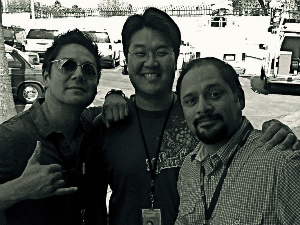BY PHIL IGE/ AAJA-LA (KTLA VIDEOGRAPHER/ 2011 AAJA-LA BOARD MEMBER)
In the world of TV news, the word interchangeability is commonly heard. Writers and producers are multi-tasking, taking on editing responsibilities in addition to their writing and producing responsibilities. Field reporters in various markets, even the Top 10, are being asked to shoot and edit in addition to their reporting responsibilities. Journalists today are taking on greater responsibilities in a downsized newsroom.
One job post that is no stranger to wearing multiple hats, on a regular basis, is the photographer.
Since my first TV news job in Bakersfield, CA back in 1998, my photographer(or photog for short) responsibilities have been more than just shooting footage for a story. It also pertained to editing, live shot set up and story telling without the partnership of a reporter.
I had a chat with two of my fellow KTLA Channel 5 news photogs, Brian Choo and Victor Vargas, both of which bring many years of experience to the news business. To bring some perspective, we discussed the role of the TV news photog of today and where they believe that role will be in the future.

KTLA 'photog' Phil Ige collecting footage at Dodger Stadium
Phil Ige: It seems like the photogs responsibilities(shoot, edit, live) haven’t changed over the years. You think they’ll stay that way?
Brian Choo(KTLA): I think it will stay this way for awhile. Maybe in 5 years, they’ll figure out a way for Skype to work and look better in HD. Look how far we’ve come in just 5 years. Cameras are getting smaller and the edit gear is getting more compact.
Victor Vargas(KTLA): The mix of responsibilities is going to change dramatically. The lines between a photog, editor, reporter, producer and technician are going to blur because of technology, economics, internal culture of a company, and the individual drive to tell a story.
Phil: With that being said, you think newsrooms will ask photogs, on a regular basis, to report the stories they shoot?
Victor: There’s other issues involved with backpack ENG(Electronic News Gathering) that are not going to be addressed by the newsroom management on a real-time basis: quality of a story, accuracy(stupid mistakes), technical issues that require trouble-shooting, and the most important, safety. For those reasons, I would not want to report on the stories I shoot. If management were more interested in enterprise reporting or a photographer’s perspective on a story, then I would consider it.
Brian: In about 5-10 years photogs will be asked to report. We do it now with VoSots and anchor packages. Photogs will just need to learn to write. I think it would be easier for photogs to be One Man Band’s than reporters. I think reporters will have a harder time adjusting to shooting, editing and gathering info. This stuff, photogs do everyday.
Phil: But would you do it, report the stories you shoot that is?
Brian: Would I do it? Yes, I would, if I want to pay my mortgage.
Phil: What do you enjoy the most about working as a TV News Photog:
Brian: The enjoyable part of being a photog is everyday is different. We meet new people, go to different places, and travel around the world. What other job does that?
Victor: Ah. One example. During one of L.A’s big fires, I went up with a helicopter crew of the L.A County Fire Department. We were about 30 feet above the ground, and we felt the heat of the flames blow inside for a split second. Scary? Heck yeah, but I don’t know anyone else that has experienced that.
Phil: Yes. I have to admit. There’s a big “neato” factor with our job. On the flip side, what’s the most challenging part of the job?
Brian: I wish I had more time to do my job right. It seems we get less and less time to make our stories really pop and sing. Time is our challenge to shoot, edit and operate a live truck.
Victor: Viewers today want everything immediately, and that includes news content. If a photographer feels he or she cannot provide quickly enough, they should pack their bags and go home. There’s been a few times that I considered doing just that. It’s a demanding job, but there’s a good feeling when the challenge is met.
Phil: Wrapping things up, what are some cliff note advice for anyone interested in getting into this business as a TV news photog?
Victor: The internet first, and then an internship. The internet has become everyone’s best friend. There’s several web-sites on digital video/editing/distribution that are run by dedicated individuals and groups who share their knowledge freely to anyone who will listen. Check out kenstone.net(my first choice), creativecow.net and apple.com(for Final Cut Pro).
Brian: Be able to work in a very stressful environment. We are in areas that are burning flooding, and shootings. Don’t freak out in stressful situations. Just be on your toes. Be a multi-tasker. We are not just photogs. We are editors, producers, writers, drivers and sometimes babysitters. Have a sense of humor.
Phil: I second on the sense of humor part.


